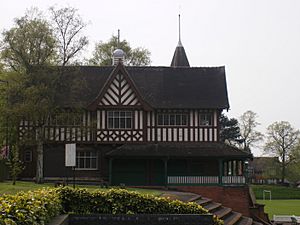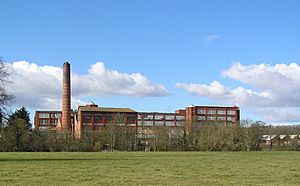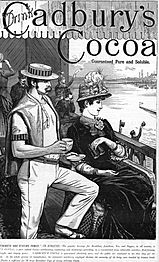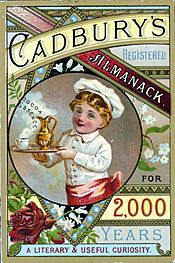History of Cadbury facts for kids
Cadbury is a famous British company that makes delicious chocolates and sweets. It's owned by a bigger company called Mondelēz International. Cadbury is actually the second biggest sweet-making brand in the world, right after Mars! Its main office is in London, England, but Cadbury sells its yummy treats in over fifty countries. You probably know their most famous chocolate, Dairy Milk.
The story of Cadbury began in 1824 when John Cadbury started selling tea, coffee, and drinking chocolate in Birmingham, England. He grew the business with his brother Benjamin, and later, his sons Richard and George took over. George Cadbury even created a special village called Bournville for the company's workers, to give them better homes. In 1905, Cadbury launched its Dairy Milk chocolate, which had more milk than other chocolates. It quickly became their most popular product by 1914.
Cadbury joined with another chocolate maker, J. S. Fry & Sons, in 1919. Later, in 1969, they teamed up with the drinks company Schweppes. Cadbury was a big company on the stock market until Kraft Foods bought it in 2010.
Contents
How Cadbury Started (1824–1900)
In 1824, John Cadbury opened a shop in Birmingham, England. He sold tea, coffee, and drinking chocolate. By 1831, he started making his own cocoa and drinking chocolates in a factory. At first, these products were quite expensive, so mostly wealthy people bought them. In 1847, John's brother Benjamin joined the business, and they called it "Cadbury Brothers."
The brothers opened an office in London. In 1854, they even received a special honour from Queen Victoria, becoming official chocolate makers for the Royal Family. However, the company faced some tough times in the late 1850s.
John Cadbury's sons, Richard and George, took over the business in 1861. At this time, the company was struggling. They had only 11 employees left and were losing money. But the brothers worked hard to turn things around. They focused more on chocolate instead of tea and coffee, and they made sure their products were very high quality. By 1864, Cadbury was making a profit again!
A big step forward happened in 1866. Richard and George brought an improved cocoa to Britain. A new machine from the Netherlands helped remove some of the bitter fat from cocoa beans. This made the chocolate taste much better. In the 1870s, Cadbury started selling its products to other countries. By the 1880s, they began making chocolate bars and sweets.
In 1878, the brothers decided to build a new factory. They chose a countryside spot about four miles from Birmingham. This was a very unusual idea for a business back then! They picked this location because it was easy to get milk by canal and cocoa by train. The new factory, called Bournville, opened the next year.
In 1893, George Cadbury bought a large piece of land near the factory. He wanted to build a special model village there. His goal was to create better homes for his workers, away from crowded city life. By 1900, the village had 314 homes. The Cadbury family were Quakers, and because of their beliefs, there were no pubs (places that sell alcohol) in the village.
In 1897, Cadbury started making its own milk chocolate bars, following the lead of Swiss companies. By 1899, Cadbury became a private company.
Growing Bigger (1900–1969)

In 1905, Cadbury launched its famous Dairy Milk bar. It was special because it had more milk than any other chocolate bar at the time. George Cadbury Jr. helped create it. This was the first time a British company could make milk chocolate in large amounts. From the very beginning, it came in its well-known purple wrapper. Dairy Milk was a huge success and became the company's best-selling product by 1914.
Cadbury also introduced a stronger cocoa powder called Bournville Cocoa in 1906. Dairy Milk and Bournville Cocoa helped the company grow very quickly before World War I. By 1914, about 40% of Cadbury's sales came from exports to other countries.
Cadbury's Milk Tray chocolates were first made in 1915. They continued to be produced even during the First World War. Over 2,000 Cadbury male employees joined the army. To help with the war, Cadbury sent clothes, books, and chocolate to soldiers. After the war, the Bournville factory was updated, and they started making products in even larger amounts.
In 1919, Cadbury joined forces with J. S. Fry & Sons, another big British chocolate maker. This brought popular sweets like Fry's Chocolate Cream and Fry's Turkish Delight into the Cadbury family. Many of Fry's smaller factories closed, and production moved to a new, larger factory in Somerdale in 1921.
Cadbury also started making chocolate overseas. In 1921, they opened their first factory outside the UK in Hobart, Tasmania, Australia.
Between the two World Wars, milk chocolate bars became much more popular in Britain than cocoa powder.
New Dairy Milk flavours were introduced: Fruit and Nut in 1928, and Whole Nut in 1933. By this time, Cadbury was the top chocolate brand in the United Kingdom. Other popular products also came out, like Flake (1920), Cream-filled eggs (1923), Crunchie (1929), and Roses (1938).
By 1930, Cadbury was one of the largest manufacturing companies in Britain. By 1936, Dairy Milk made up 60% of all milk chocolate sold in the UK. Chocolate was no longer just for the rich; it became affordable for everyone. By the mid-1930s, Cadbury thought that 90% of British people could buy chocolate.
During World War II, parts of the Bournville factory were used to make things for the war, like parts for fighter aircraft. Workers even planted crops on football fields to help feed the country. Chocolate was seen as an important food, so the government watched over its production during the war. Chocolate rationing ended in 1950, and normal production started again. Cadbury then built new factories because more and more people wanted their products.
In 1952, the Moreton factory was built. In 1956, Cadbury began making chocolate in Bombay (India).
In 1967, Cadbury bought an Australian sweet company called MacRobertson's. This helped Cadbury gain a 60% share of the Australian market. This purchase also added popular treats like Freddo and Snack to Cadbury's range.
Joining and Splitting Up (1969–2007)
In 1969, Cadbury merged with a drinks company called Schweppes to form Cadbury Schweppes. The head of Schweppes, Lord Watkinson, became the chairman. This merger changed Cadbury's focus a bit, moving away from its original family values towards a more business-focused approach.
The 1970s saw new chocolate bars being created, such as the Curly Wurly, the Double Decker, and Caramel. Sales of Flake also grew a lot after a famous advertising campaign. However, when Rowntree launched the Yorkie chocolate bar in 1976, it affected Dairy Milk sales. Cadbury's share of the UK market dropped to 20%. To fix this, Cadbury reduced the number of different products they made and put new, advanced machines in the Bournville factory.
In 1978, the company bought Peter Paul, a large chocolate maker in the United States. This gave Cadbury a 10% share of the biggest sweet market in the world. The very popular Wispa chocolate bar was first launched in 1981 and then across the whole country in 1984. By 1982, Cadbury was making more money outside Britain than inside the UK for the first time.
In 1986, Cadbury Schweppes sold its drinks and food parts to a company called Premier Brands. This meant Cadbury no longer owned brands like Typhoo Tea, Kenco coffee, or Smash instant mashed potato. In 1988, Cadbury's US chocolate business was sold to Hershey.
Cadbury Schweppes also became a major player in soft drinks. In 1986, they teamed up with Coca-Cola in the UK. They also bought Canada Dry and Sunkist drinks. These deals made Cadbury Schweppes the third largest soft drink maker in the world.
In 2003, Cadbury changed its name slightly, dropping the 's' from "Cadbury's" to just "Cadbury." They felt it sounded better and more complete.
In March 2007, Cadbury Schweppes announced they would split into two separate companies. One would focus on chocolate and sweets, and the other on their US drinks business. This split happened on 2 May 2008, and the drinks company became Dr Pepper Snapple Group. In December 2008, Cadbury sold its Australian drinks business to Asahi Breweries.
Recent Years (2007–2010)
In October 2007, Cadbury announced they would close the Somerdale Factory in Keynsham, which used to be part of Fry's. This meant between 500 and 700 jobs were affected. Production moved to other factories in England and Poland.
In 2009, Cadbury changed some of the ingredients in their chocolate products outside the UK. They replaced some cocoa butter with palm oil. They said this was to make the taste and texture better. However, many people, especially environmentalists, were upset about this change. By August 2009, the company announced they would go back to using cocoa butter in New Zealand. They also promised to get cocoa beans through Fair Trade channels, which helps farmers get a fair price for their crops.
Bought by Kraft Foods

On 7 September 2009, a big American food company called Kraft Foods offered to buy Cadbury. Cadbury said no, because they felt the offer was too low. Kraft then made a formal offer on 9 November 2009. Some people in the British government warned Kraft not to just buy Cadbury to make a quick profit.
On 19 January 2010, Cadbury and Kraft Foods finally agreed on a deal. Kraft would buy Cadbury for about £11.5 billion (around US$18.9 billion). Kraft said this deal would create a "global confectionery leader."
Another chocolate company, The Hershey Company from the US, was also interested in buying Cadbury. They wanted to sell more chocolate in other countries. But on 22 January 2010, Hershey announced they would not try to outbid Kraft.
Many people in Britain were unhappy about Kraft buying Cadbury. Trade unions worried that many jobs could be lost. It was also controversial because a bank partly owned by the UK government, RBS, helped Kraft get the money for the takeover.
On 2 February 2010, Kraft gained control of over 71% of Cadbury's shares, which made the deal final. By 5 February 2010, Kraft had enough shares to fully take over Cadbury.
Soon after, on 9 February 2010, Kraft announced they would close the Somerdale Factory in Keynsham, leading to 400 job losses. This upset the workers, who felt betrayed because they had been given promises about keeping the factory open.
In June 2010, Cadbury's Polish business, Cadbury-Wedel, was sold to a Korean company called Lotte. This sale was a condition set by the European Commission for Kraft to be allowed to buy Cadbury.
On 4 August 2011, Kraft Foods announced it would split into two companies. From 1 October 2012, the part of Kraft that makes sweets and chocolates became Mondelēz International, and Cadbury is now part of this company.
Images for kids







